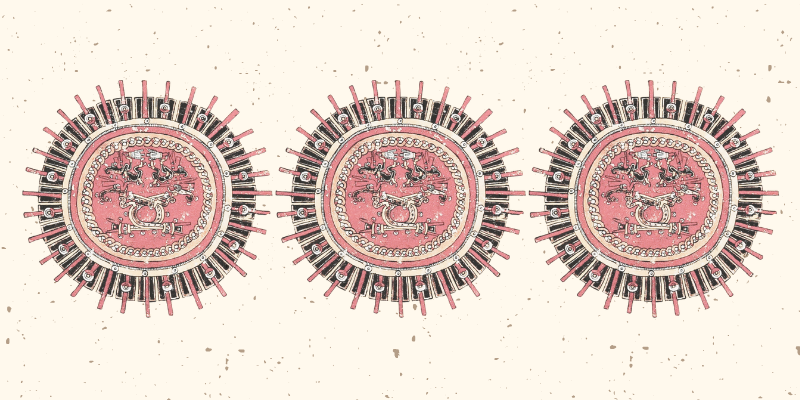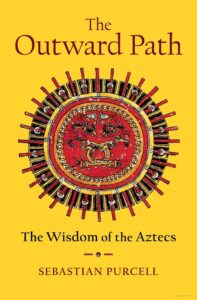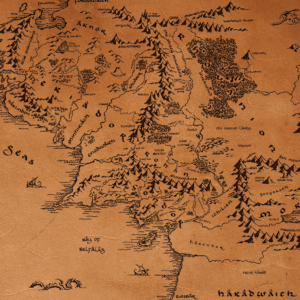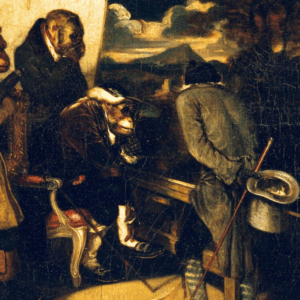
How We Can Achieve a Good Life Through the Help of Others
Sebastian Purcell On Finding the Path to Happiness Using Aztec Philosophy
The “pursuit of happiness” figures into the United States of America’s Declaration of Independence as an inalienable right. When Thomas Jefferson penned the line, he was recalling a standard and ancient view of the good life in the history of “Western” philosophy. The opening lines of Aristotle’s Nicomachean Ethics, written some 2,100 years earlier, declare, “Every craft and every inquiry, and similarly every action and choice, seems to seek some good; that is why some people rightly described the good as what everything seeks.” Aristotle goes on to dub this apex good; our main goal in life, “happiness.”
Of course, Aristotle later develops “happiness” in a technical way, rather distant from our colloquial English meaning. Jefferson gave Aristotle’s idea a modern twist by framing the pursuit of happiness as both a legal and an existential right. Still, there is something of a tradition visible across the millennia. Today it appears that hardly anyone can conceive of an alternative goal for their lives. If not happiness, then what exactly is it that we should be otherwise pursuing? Misery?
But what if the “West’s” conventional wisdom is wrong? What if we only think of happiness as a goal because we have lost sight of other alternatives? What if the heart of the problem is a lack of imagination? Aztec philosophers would urge us to reconsider our “Western” position. They would implore us to question the conventional wisdom of our culture. You are not really after “happiness,” they would tell us, you just think that you are.
Aren’t you willing to sacrifice your happiness for those who you love? Isn’t that, to put it another way, exactly what it means to love someone?
A scene from Homer’s Odyssey underscores the Aztec point. It occurs after Odysseus has been shipwrecked on his homeward voyage and has been living on an island with the goddess Calypso for seven years. He has been crying and lamenting his fate, and the gods take pity on him. Hermes arrives and informs Calypso of Zeus’s decision to have Odysseus leave. She agrees, provided that she may attempt one last time to convince him to stay. In the next scene, we witness Odysseus seated across from Calypso. She offers him what any human would apparently want: immortality, agelessness, and a leisured existence on an island paradise with the romantic company of a goddess. He turns her down, choosing instead to build a raft and then venture onto the open waters in search of his wife and child.
Unlike the biblical Adam and Eve who are forced from paradise, Odysseus chooses to leave. That choice might at first seem puzzling, but Aztec philosophers would be willing to bet that you would make the same choice. Aren’t you willing to sacrifice your happiness for those who you love? Isn’t that, to put it another way, exactly what it means to love someone?
Now a reasonable rejoinder is that Odysseus is given the prospect of infinite, or at least indefinite, happiness. Isn’t that result something entirely different from our lives of mundane sacrifice, ones where you and I exchange definitive pleasures and pains? The Aztecs would wager that this indefinite prospect matters very little. To prove it, let’s move from this hypothetical commitment to the real commitment many have already made—and if you haven’t made it yet, to one that an overwhelming majority of you intend to make—namely the choice to have children.
Most spring semesters, I teach a class called Happiness. It’s always packed with students because, like most people, they want to learn the secret to feeling fulfilled. “How many of you want to be happy in life?” I ask. Everyone raises a hand. “How many of you are planning to have children?” Almost everyone raises their hand again.
Then I lay out the evidence that having children diminishes most people’s “happiness.” Here is a taste of that evidence:
– A study found that parental levels of well-being drop off after the very first child, perhaps explaining why parents in more well-off countries, where childbirth is largely elective, tend to have only one or two children.
– According to four separate studies, marital satisfaction drops steadily until a couple’s children age to between twelve and sixteen years; and couples only return to previous levels of satisfaction after the last child has left the house. Empty nest syndrome, it turns out, is largely a myth.
– Another study found that those with the most active lifestyles before having children are the most likely to experience a drop in feelings of well-being.
– Finally, while parenthood is likely to contribute to life satisfaction on its own, the positive effects are (for most) entirely negated by the costs of child-rearing (both in terms of time and money).
After presenting this material to my classroom, I give my students a second chance: “How many of you still want children?” I say. Maybe it’s just obstinacy, but the same people who wanted to be happy at the beginning of class raise their hands.
Like Odysseus’s choice to leave paradise to find his wife and child, my students choose to have children even though they know that having them is likely to diminish their “happiness.” Since, generally, they are not yet parents, they do not object, as parents often do, that children are a great source of happiness. The students recognize what many often confuse, namely that some things in life are more important than elevated emotional states. And if we must make sacrifices to achieve these more important things, then so much the worse for “happiness.”
Such would be the first Aztec lesson on the good life if they could speak to us today: You should stop searching for happiness, because that’s not really what you want. When given the direct choice between a pleasurable, happy course of action and a meaningful one bound up with commitments to our closest few, we consistently choose something other than happiness.
In a genre unique to Aztec culture called the “discourses of the elders” (huehuetlatolli / way-weh-tla-TOL-lee), you can find speeches and dialogues that consider the nuances of happiness wherein elders, often fathers and mothers, speak to younger persons, often their sons and daughters, with the goal of educating them on how best to live. In an exchange with his daughter, recorded in volume 6 of the Florentine Codex, a father delivers the following speech.
“O my daughter, my child, hear well: the earth [tlalticpac] is not a good place. It is not a place of happiness [pacoaia] or contentment. It can only be said that the earth [tlalticpac] is a place of happiness-fatigue, happiness-pain,” so the elders often say. That we may not go on weeping forever, we are in debt to Our Lord, who gave us laughter and sleep, our food and strength, our life and love.
The father implores his daughter to recognize that human life on earth isn’t simply a “happy” one. Though you and I might escape great tragedies, lesser ones are bound to dapple the smooth veneer of our lives. “Happiness” comes and goes in waves. The Nahuatl language has at least three terms for “happiness”: paqui (PAH-kee), ahuiya (a-WEE-ya), and huellamati (wel-a-MAT-ee).
With the pursuit of happiness comes the pursuit of its opposite.
The first means happiness as experiencing pleasure and enjoying yourself. The second means happiness as having what’s necessary, or perhaps indulging a bit. The final term means happiness as contentment, but its related terms may suggest a connection with the pleasure of taste.
At stake in this passage about the father and daughter is a form of paqui, the happiness of pleasure and enjoyment. We only ever experience these states in contrast with their opposites, joy then pain, or joy then fatigue. The pursuit of happiness, so understood, proves an impossible goal because it is not even a logically coherent candidate for a good life. With the pursuit of happiness comes the pursuit of its opposite.
My fellow philosophers might have more elaborate conceptions of “happiness” in mind, such as an “all things considered” view. For example, you might distinguish short-term happiness from long-term happiness, and then develop a principle for how to balance these competing goals. In general, such views distinguish forms of happiness and suggest a program for discerning what’s the best overall view.
Maybe one of those approaches is the right one. But the Aztecs would point out that these types of intellectual reconstructions often settle on conceptual shores far from our ordinary discourse about “happiness.” Why not pursue a more forthright path and admit that the good life has nothing to do with “happiness” in the colloquial sense? Could we not then consider the Aztecs’ positive proposal, that we are instead after a rooted life?
Though long excluded from academic consideration, undeniable evidence shows that the Aztecs were a philosophical people. Even more interesting, they advanced views about human life that both challenge dominant points of agreement in “Western” philosophy and might be right in their challenge. You’ve just learned of one such lesson, that you are not after happiness, though you may think you are, but a single thread in a tapestry of wisdom which answers a common human question: How shall we live?
*
If we are to learn any of their other answers to this concern, then we must take the Aztecs seriously. The Aztecs, more accurately referred to as the Nahuas because they spoke Nahuatl, have, by turns, both fascinated and mortified “Westerners” since the Spanish officer Hernán Cortés first encountered them in the early 1500s. The nineteenth-century historian William H. Prescott, writing in what is today still among the most widely read books of the Spanish-Aztec war, crystallizes this ambivalence:
In contemplating the religious system of the Aztecs, one is struck with its apparent incongruity, as if some portion of it had emanated from a comparatively refined people, open to gentle influences, while the rest breathes a spirit of unmitigated ferocity.
Much of that view, in my judgment, still rests comfortably in our broader cultural imagination.
Yet Prescott penned those lines in 1843, and his view is, to a significant degree, mistaken. In the nearly two centuries that have since intervened, a cohort of multidisciplinary specialists have shown us just what he was missing. Archaeologists and anthropologists have revealed that Prescott did not have available to him the entirety of the Florentine Codex, which is a principal source for our understanding of the Aztecs. Moreover, many of the major architectural and artistic artifacts of the Aztecs remained buried under the central square of Mexico City while he wrote. Linguistic studies nearly a century after Prescott identified, through the separate work of Richard Andrews and Michel Launey, that Nahuatl has an especially peculiar feature: It has no words.
Instead, it has “nuclear clauses,” so that individual terms may act as complete sentences on their own. The term michin, for example, is typically translated into English as the noun “fish.” But were it to appear on its own, it would stiltedly read as “it is a fish,” thus serving as its own sentence. Historians of the era have worked to correct myriad misconceptions about Montezuma, Cortés, and the global events that are often called the “conquest” of the Aztecs. Matthew Restall, for example, has worked indefatigably as a myth buster for dozens of misconceptions for roughly two decades now, and only recently did another historian, Camilla Townsend, stitch together the history of the Aztecs according to their own statements, as recorded in Nahuatl.
There is a formula intrinsic to the Aztecs’ worldview that insists that we are after a meaningful and worthwhile life, a rooted one, rather than a happy one.
In the context of these intellectual efforts, philosophers have, like the owl of Minerva, arrived at dusk, that is to say, with most of the day’s intellectual labor now complete. Nevertheless, I understand this book to constitute a contribution to the reevaluation of the Aztecs. I do wish to note, however, that the resulting view of the Aztecs will differ from what these other disciplines have represented—and for good reason. Philosophy responds to its own set of questions. In the Postface to this book, I explain what methodological assumptions guide my research, the tradition of analysis that I use, and why I think this approach is best given the centuries of cultural misrecognition the Aztecs have faced.
What you most need to understand is that the field is young and nearly everyone has a different view. My purpose in this book is to provide you with a contemporary reconstruction of Aztec philosophy—advancing an interpretive tradition favored in Mexico—that could be practiced today. Something similar transpires when philosophers address other ancient traditions in the world’s canon. The philosopher Daniel Russell, for example, defends an “updated” form of Aristotle’s virtue ethics in his Practical Intelligence and the Virtues. Author and philosopher Massimo Pigliucci defends an updated form of Stoicism in his How to Be a Stoic. I see no reason why we cannot treat the Aztecs similarly—learning from ancient sources to address our modern concerns. This reconstruction will inevitably differ from what contact-era (1519–1640) Aztecs would have said in no small part because it is updated according to our best (scientific) evidence today. But it should, for just these reasons, be of interest to the broader public.
*
There is a formula intrinsic to the Aztecs’ worldview that insists that we are after a meaningful and worthwhile life, a rooted one, rather than a happy one. The formula lays out for us the secret to enduring trials, how to enjoy the peaks of life, how to form lasting romantic partnerships, how to find your purpose, how to live with nature, and how to be well in both physical and emotional senses.
It is a formula that Nezahualcoyotl (Neza-wal-COY-ot / Hungry Coyote), the philosopher king of Tezcoco, followed while transforming his city into a flourishing arts and cultural center and toward a peaceful succession of power after his death in 1472. It is a view that finds a surprisingly clear articulation in Simón Bolívar’s philosophical and political writings, as he led Venezuela, Colombia, Ecuador, Peru, Bolivia, and Panama to independence from European powers in the early 1800s. And, of course, it is a view that sustained Emiliano Zapata, in the early twentieth century, as he led the rural and Indigenous peoples of Mexico to revolutionary action.
You and I may not be kings, or liberators, or revolutionaries, but the world tests us all the same. If there is wisdom here that could sustain them through their trials, that could enable them to find meaning and joy in dark times, then perhaps we might find some solace ourselves.
For more than half a century, the United States has served as a laboratory for the modern popular exploration of ancient philosophies, from the reception of (especially Zen) Buddhism in the 1960s, to the recent resurgence of interest in ancient Greek and Roman Stoicism. The Aztecs offer a distinctive new voice in the chorus of recovered ancient wisdom. Without simplifying too much, what has been recovered of philosophical texts around the globe follows an inward path. The Stoic philosopher Epictetus begins The Handbook with the following claim:
Some things are up to us and some are not up to us. Our opinions are up to us, and our impulses, desires, aversion—in short whatever is our doing. Our bodies are not up to us, nor are our possessions, our reputations, or our public offices, or, that is whatever is not our doing.
The Stoic path to the good life, then, is one of detachment. One must learn to assent to the things under one’s control and to let the rest go. It is the inward work on oneself, then, that leads toward a better life.
The form of Buddhism that has been imported to the “West” is primarily Zen Buddhism, and when approached from a Western perspective, the task is similarly inward-looking. Consider, for example, the purpose of the koan exercises. A novitiate might receive one of the following problems to work on:
– What was the appearance of your face before your parents were born?
– We are all familiar with the sound of two hands clapping. What is the sound of one hand clapping?
The pupil working at this initial (hosshin) stage is meant to undertake meditative practice (zazen) and work on a solution until their mind is exhausted. In the first case, the pupil might return to the master with a description of their face, or a leaf, or a rock—all of which would be dismissed as wrong. Then, after significant toil, and in a moment of exasperation, the student will have a flash of insight into some basic, ineffable truth. They will thus have taken their first real steps toward satori, enlightenment.
The path toward enlightenment lies in understanding and working on your inward self.
Zen Buddhism is unlike Stoic philosophy on the role of discursive, as opposed to intuitive, reasons. Zen Buddhism holds that the enlightenment that we each seek cannot be formulated into words, and instead must come from direct intuition; while Stoicism made significant advances in formal logic and requires its followers to master that. In both cases, however, the path to a better life is still inward looking. It still proceeds through one’s ordinary consciousness, whether in logical reflection, or in working on a koan, until your individual, rational mind is exhausted. The path toward enlightenment lies in understanding and working on your inward self.
Aztec rootedness, by contrast, follows an outward path. The aim is to look outward, in the right way, to stabilize oneself internally. In a long discourse, recorded as one of the preserved Discourses of the Elders, a father tells his son that there are two paths in life: the path of principles, of excellence, and the path of the rabbit and the deer. On the first path, the father tells his son, you will be able to stand on your feet, to be rooted, by living alongside human society. On the second path, the path of the rabbit and the deer, he warns, you will harm your character and lead a broken life. You will not even “emerge as a human.”
Let me illustrate this outward path with a story. When Halloween last arrived, my wife and I were prepared to be greeted by scores of eager trick-or-treaters. Guided by the thought that too much candy was better than too little, we bought entirely too much, and, after the holiday, poured the excess onto a platter in our living room. The problem is: I have a sweet tooth. “I can’t stop eating these!” I said to my wife, peevishly, a few days later. Nearly every time I passed the coffee table, I succumbed to my cravings for a sugar rush, and would immediately feel frustrated and irritated. When I returned from work that evening, I noticed the platter was empty. “Oh, I just took it to work and gave it away to the students,” my wife said, when I asked. Just like that, my cycle of transgression and guilt was broken.
This anecdote illustrates two ways in which the Aztec path is distinct from “Western” philosophy, such as Aristotle’s or the Stoics’, as much as from “Eastern” paths to enlightenment, such as Zen Buddhism. The first is that I did not overcome my vice so much as manage it. The second is that I did not manage it on my own, but rather did so (almost entirely) with the help of another person.
The fact that my wife did most of the work illustrates what I mean by the outward path. The Aztecs believed that you learn to live well by living with others and by means of their help. The goal is to set up your circumstances and relationships in the right way. If those are set up well, they thought, then you will learn to manage your interior self. That is the path to a good life.
__________________________________

Excerpted from The Outward Path: The Wisdom of the Aztecs. Copyright © 2025 by Sebastian Purcell. Used with permission of the publisher, W. W. Norton & Company, Inc. All rights reserved.
Sebastian Purcell
Sebastian Purcell is an award-winning associate professor of philosophy at SUNY-Cortland in New York, where he researches ethics, Aztec philosophy, and mathematical logic. He resides in Binghamton, New York.












